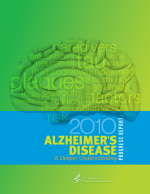 2010 Alzheimer’s Disease Progress Report: A Deeper Understanding, the latest annual Alzheimer’s research report from the National Institutes of Health (NIH), is now available online. Prepared by the National Institute on Aging, which leads the NIH effort conducting and supporting research on age-related cognitive decline and Alzheimer’s disease, the report highlights important developments and directions in NIH-funded research, including:
2010 Alzheimer’s Disease Progress Report: A Deeper Understanding, the latest annual Alzheimer’s research report from the National Institutes of Health (NIH), is now available online. Prepared by the National Institute on Aging, which leads the NIH effort conducting and supporting research on age-related cognitive decline and Alzheimer’s disease, the report highlights important developments and directions in NIH-funded research, including:
- risk for developing Alzheimer’s
- genes that play a role in the disease
- neuroimaging and biomarkers that detect and track the disease
- research into new treatments
- lifestyle factors that may worsen or protect against the disease
- help for caregivers
Special features include animation showing the progression of Alzheimer’s in the brain and video interviews highlighting new insights into the disease.
Read online or download @ http://www.nia.nih.gov/alzheimers/publication/2010-alzheimers-disease-progress-report-deeper-understanding.
Related Articles:
- Alzheimer’s Disease “Jumps” Across Brain Cells to Spread (pdresources.wordpress.com)
- New Alzheimer’s Criteria Would Change Diagnosis for Millions (pdresources.wordpress.com)
- Obama to boost Alzheimer’s research funding (cnn.com)


![Video2 Using structural MRI to map the functional anatomy of language and reading [electronic resource] / Cathy Price.](http://pdresources.files.wordpress.com/2011/08/video2.jpg?resize=330%2C394)
